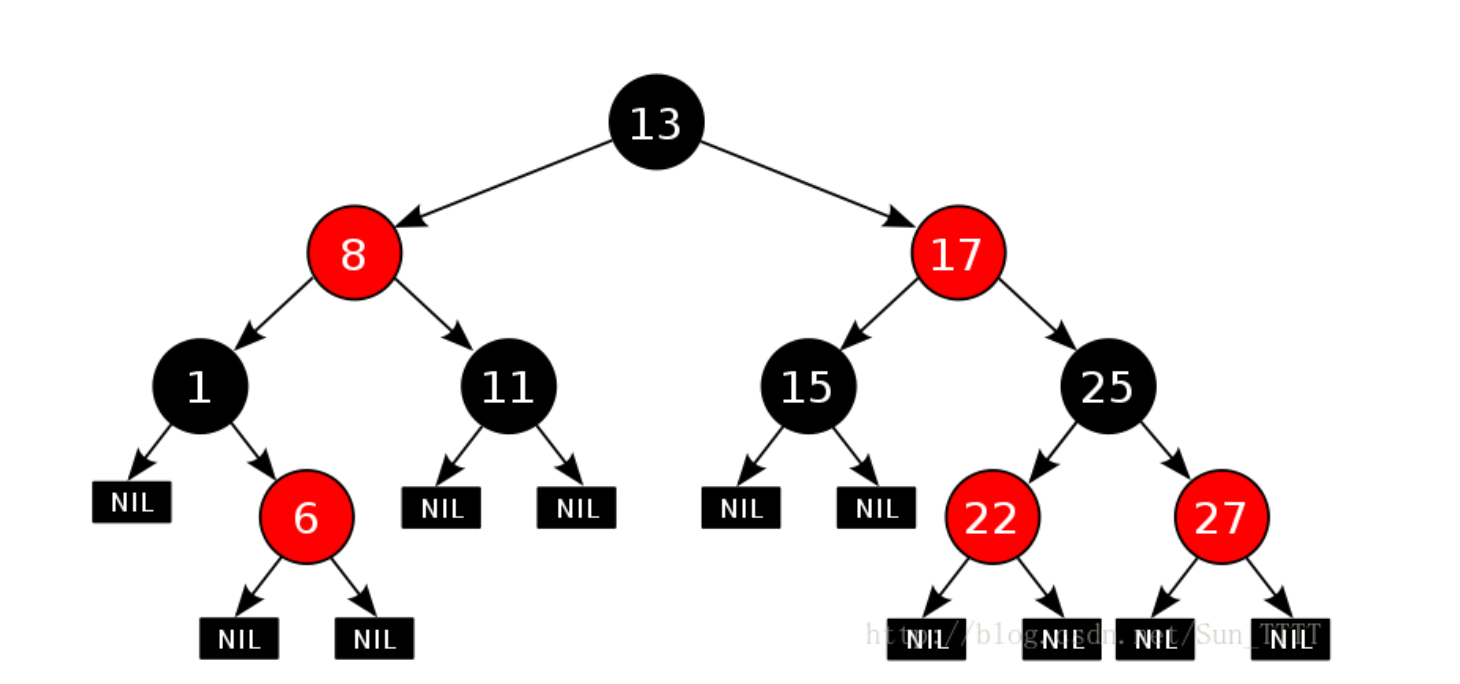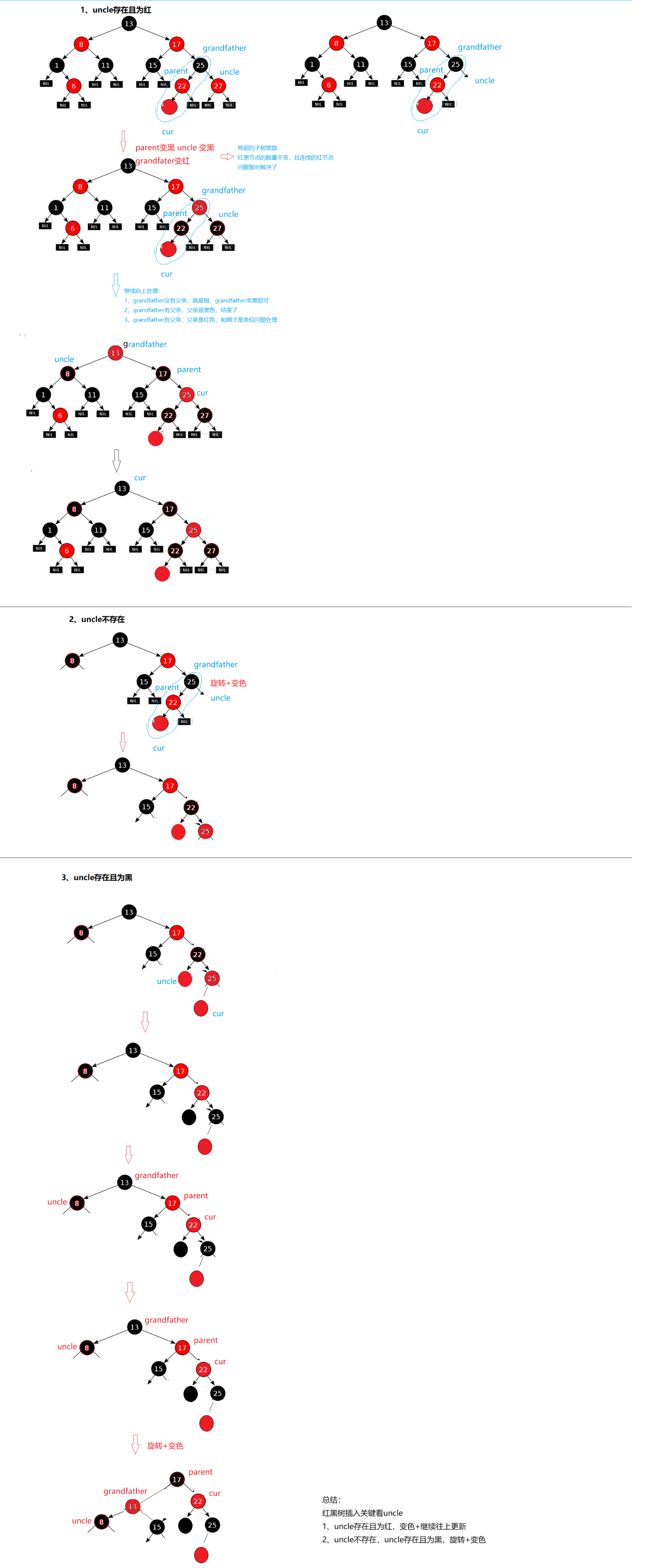1红黑树的概念
AVL树和红黑树的比较
想出AVL树的人时大佬,想出红黑树的人是天才
他俩的性能是同一量级的,但是AVL树的严格平衡时要付出代价的,插入和删除的时候会大量旋转
AVL树维持那么高的精度是没有必要的
红黑树,是一种二叉搜索树,但在每个结点上增加一个存储位表示结点的颜色 ,可以是Red或 Black。 通过对任何一条从根到叶子的路径上各个结点着色方式的限制,红黑树确保没有一条路 径会比其他路径长出俩倍,因而是接近平衡的。

2 红黑树的性质和定义
每个结点不是红色就是黑色
根节点是黑色的
如果一个节点是红色的,则它的两个孩子结点是黑色的
对于每个结点,从该结点到其所有后代叶结点的简单路径上,均 包含相同数目的黑色结点
每个叶子结点都是黑色的(此处的叶子结点指的是空结点)
思考:为什么满足上面的性质,红黑树就能保证:其最长路径中节点个数不会超过最短路径节点 个数的两倍?
原因:当一条路径全为黑色的时候是最短的,当红与黑交替出现的时候是最大的,而且这两种情况当中黑色都个数都是相同的,那么极端情况下是二倍关系
先来复习一下枚举
3 红黑树节点的插入
红黑树是在二叉搜索树的基础上加上其平衡限制条件,因此红黑树的插入可分为两步:
-
按照二叉搜索的树规则插入新节点
-
检测新节点插入后,红黑树的性质是否造到破坏 因为新节点的默认颜色是红色,因此:如果其双亲节点的颜色是黑色,没有违反红黑树任何 性质,则不需要调整;但当新插入节点的双亲节点颜色为红色时,就违反了性质三不能有连 在一起的红色节点,此时需要对红黑树分情况来讨论: 约定:cur为当前节点,p为父节点,g为祖父节点,u为叔叔节点
红黑树的插入要分三种情况
1,uncle 存在且为红
那么就让uncle和parent都变黑,让grandfather变红,然后cur到grandfather的位置继续向上判断
继续向上处理的条件:
1 grandfather没有父亲,就是根,grandfather变黑即可
2 grandfather有父亲,父亲是黑,结束了
3 grandfather由父亲,父亲是红,跟刚才是类似的问题去处理
2,uncle 不存在
那么这时候就要去旋转即可,根据三者位置关系决定是左单旋还是右单旋还是双旋,旋转之后,让parent为红,grandfather为黑,就满足红黑树的要求了(旋转+变色)
3 ,uncle 存在且为黑
这时候单旋转和变色都不能解决问题了,要两个一起使用(旋转+变色)

抽象图
注意这里不是以高度来论, 而是黑节点的个数
情况一: cur为红,p为红,g为黑,u存在且为红 
情况二: cur为红,p为红,g为黑,u不存在/u存在且为黑 
情况三: cur为红,p为红,g为黑,u不存在/u存在且为黑
这里就是双旋
插入代码
cpp
bool Insert(const pair<K, V>& kv)
{
if (_root == nullptr)
{
_root = new Node(kv);
_root->_col = BLACK;
return true;
}
Node* cur = _root;
Node* parent = nullptr;
while (cur)
{
if (cur->_kv.first < kv.first)
{
parent = cur;
cur = cur->_right;
}
else if (cur->_kv.first > kv.first)
{
parent = cur;
cur = cur->_left;
}
else
{
return false;
}
}
//找到插入的位置
cur = new Node(kv);
if (parent->_kv.first < kv.first)
{
parent->_right = cur;
}
else
{
parent->_left = cur;
}
cur->_parent = parent;
while(parent && parent->_col ==RED)
{
//parent为红,要去看uncle,注意这里一定会有grandfather
Node* grandfather = parent->_parent;
if (grandfather->_left == parent)
{
Node* uncle = grandfather->_right;
//1如果uncle存在且为红
if (uncle && uncle->_col == RED)
{
parent->_col = uncle->_col = BLACK;
grandfather->_col = RED;
cur = grandfather;
parent = cur->_parent;//若parent 为空那么grandfather就是根要将根置黑
//而且还要继续
}
else
{
//2uncle不存在/或者为黑
//这时候就要旋转了,根据g p c 的位置直接旋转
if (parent->_left == cur)
{
RotateR(grandfather);
parent->_col = BLACK;
grandfather->_col = RED;
}
else
{
RotateL(parent);
RotateR(grandfather);
cur->_col = BLACK;
grandfather->_col = RED;
}
break;
}
}
else//grandfather->_right == parent
{
Node* uncle = grandfather->_left;
if (uncle && uncle->_col == RED)
{
parent->_col = uncle->_col = BLACK;
grandfather->_col = RED;
cur = grandfather;
parent = cur->_parent;
}
else
{
//2uncle不存在/或者为黑
//这时候就要旋转了,根据g p c 的位置直接旋转
if (parent->_right == cur)
{
RotateL(grandfather);
parent->_col = BLACK;
grandfather->_col = RED;
}
else
{
RotateR(parent);
RotateL(grandfather);
cur->_col = BLACK;
grandfather->_col = RED;
}
break;
}
}
}
_root->_col = BLACK;
return true;
}4红黑树的检查
1检查是否有两个连续的红节点
2每条路径黑色节点的数量是否一致
cpp
//红黑树的验证有两点,1不能有连续的红节点,2所有路径的黑节点数量相同
bool _isBalance(Node* root)
{
if (root == nullptr)
{
return true;
}
//计算出一个基准值
int basline = 0;
Node* cur = root;
while (cur)
{
if (cur->_col == BLACK)
++basline;
cur = cur->_left;
}
return Checkcolor(root,0, basline);
}
bool Checkcolor(Node* root,int blacknum,int basline)
{
if (root == nullptr)
{
if (blacknum != basline)
{
return false;
}
return true;
}
if (root->_col == BLACK)
++blacknum;
if (root->_col == RED && root->_parent && root->_parent->_col == RED)
{
return false;
}
return Checkcolor(root->_left,blacknum,basline)
&& Checkcolor(root->_right, blacknum, basline);
}5 红黑树模拟实现STL中的map与set
底层都是用红黑树,map和set都是对红黑树的封装
5.1 红黑树的迭代器
迭代器的好处是可以方便遍历,是数据结构的底层实现与用户透明。如果想要给红黑树增加迭代 器,需要考虑以前问题:
begin()与end() STL明确规定,begin()与end()代表的是一段前闭后开的区间,而对红黑树进行中序遍历后, 可以得到一个有序的序列,因此:begin()可以放在红黑树中最小节点(即最左侧节点)的位 置,end()放在最大节点(最右侧节点)的下一个位置,关键是最大节点的下一个位置在哪块? 能否给成nullptr呢?答案是行不通的,因为对end()位置的迭代器进行--操作,必须要能找最 后一个元素,此处就不行,因此最好的方式是将end()放在头结点的位置:
1右不为空, 访问右树的最左节点
2右为空,(1如果child是parent的左访问parent,2如果child是parent的右,此时说明父亲已经访问里,就去访问祖先)
代码展示:
cpp
template <class T, class Ptr, class Ref>
struct __TreeIterator
{
typedef RBTreeNode<T> Node;
typedef __TreeIterator<T, Ptr, Ref> Self;
typedef __TreeIterator<T, T*, T&> Iterator;
Node* _node;
__TreeIterator(Node* node)
:_node(node)
{
}
//这个构造是为了让普通迭代器构造一个const迭代器
__TreeIterator(const Iterator& it)
:_node(it._node)
{
}
Ref operator* ()
{
return _node->_data;
}
Ptr operator->()
{
return &_node->_data;
}
bool operator!=(const Self& s)
{
return _node != s._node;
}
//--的操作与加加相反
Self& operator--()
{
if (_node->_left)
{
//找到左树的最大
Node* subRight = _node->_left;
while (subRight->_right)
{
subRight = subRight->_right;
}
_node = subRight;
}
else
{
Node* cur = _node;
Node* parent = _node->_parent;
while (parent && cur ==parent->_left)
{
cur = parent;
parent = parent->_parent;
}
_node = parent;
}
return *this;
}
Self& operator++()
{
if (_node->_right)
{
//找到右树的最小
Node* subLeft = _node->_right;
while (subLeft->_left)
{
subLeft = subLeft->_left;
}
_node = subLeft;
}
else
{
Node* cur = _node;
Node* parent = _node->_parent;
while(parent && cur == parent->_right)
{
cur = parent;
parent = parent->_parent;
}
_node = parent;
}
return *this;
}
};5.2set
cpp
#include "RBTree.h"
namespace cy
{
template<class K>
class set
{
struct SetKeyOfT
{
const K& operator()(const K& key)
{
return key;
}
};
public:
//普通迭代器和const迭代器都不能修改
typedef typename RBTree<K, K, SetKeyOfT>::const_iterator iterator;
typedef typename RBTree<K, K, SetKeyOfT>::const_iterator const_iterator;
const_iterator begin() const
{
return _t.begin();
}
const_iterator end() const
{
return _t.end();
}
pair<iterator,bool> insert(const K& key)
{
//这里pair<iterator,bool> Insert返回的是普通迭代器RBTree::iterator
//但是在set这一层iterator 是const_iterator
//在类模板里面取内嵌类型要加typename
pair<typename RBTree<K,K,SetKeyOfT>::iterator, bool> ret = _t.Insert(key);
return pair<iterator, bool>(ret.first, ret.second);
}
private:
RBTree<K, K, SetKeyOfT> _t;
};
}5.3map
cpp
#include "RBTree.h"
namespace cy
{
template<class K,class V>
class map
{
struct MapKeyOfT
{
const K& operator()(const pair<K, V>& kv)
{
return kv.first;
}
};
public:
typedef typename RBTree<K, pair<const K, V>, MapKeyOfT>::iterator iterator;
typedef typename RBTree<K, pair<const K, V>, MapKeyOfT>::const_iterator const_iterator;
iterator begin()
{
return _t.begin();
}
iterator end()
{
return _t.end();
}
const_iterator begin()const
{
return _t.begin();
}
const_iterator end()const
{
return _t.end();
}
pair<iterator,bool> insert(const pair<K, V>& kv)
{
return _t.Insert(kv);
}
V& operator[](const K& key)
{
pair<iterator, bool> ret = insert(make_pair(key, V()));
return ret.first->second;
}
private:
RBTree<K, pair<const K,V>, MapKeyOfT> _t;
};
}底层红黑树代码
cpp
#pragma once
enum Color
{
RED,
BLACK
};
template <class T>
struct RBTreeNode
{
RBTreeNode(const T& data)
:_left(nullptr)
,_right(nullptr)
,_parent(nullptr)
,_data(data)
,_col(RED)
{ }
RBTreeNode<T>* _left;
RBTreeNode<T>* _right;
RBTreeNode<T>* _parent;
Color _col;
T _data;
};
template <class T, class Ptr, class Ref>
struct __TreeIterator
{
typedef RBTreeNode<T> Node;
typedef __TreeIterator<T, Ptr, Ref> Self;
typedef __TreeIterator<T, T*, T&> Iterator;
Node* _node;
__TreeIterator(Node* node)
:_node(node)
{
}
//这个构造是为了让普通迭代器构造一个const迭代器
__TreeIterator(const Iterator& it)
:_node(it._node)
{
}
Ref operator* ()
{
return _node->_data;
}
Ptr operator->()
{
return &_node->_data;
}
bool operator!=(const Self& s)
{
return _node != s._node;
}
//--的操作与加加相反
Self& operator--()
{
if (_node->_left)
{
//找到左树的最大
Node* subRight = _node->_left;
while (subRight->_right)
{
subRight = subRight->_right;
}
_node = subRight;
}
else
{
Node* cur = _node;
Node* parent = _node->_parent;
while (parent && cur ==parent->_left)
{
cur = parent;
parent = parent->_parent;
}
_node = parent;
}
return *this;
}
Self& operator++()
{
if (_node->_right)
{
//找到右树的最小
Node* subLeft = _node->_right;
while (subLeft->_left)
{
subLeft = subLeft->_left;
}
_node = subLeft;
}
else
{
Node* cur = _node;
Node* parent = _node->_parent;
while(parent && cur == parent->_right)
{
cur = parent;
parent = parent->_parent;
}
_node = parent;
}
return *this;
}
};
template <class K, class T, class KeyOfT>
class RBTree
{
typedef RBTreeNode<T> Node;
public:
typedef __TreeIterator<T,T*, T&> iterator;
typedef __TreeIterator<T, const T*, const T&> const_iterator;
iterator begin()
{
Node* leftMin = _root;
while (leftMin && leftMin->_left)
{
leftMin = leftMin->_left;
}
return iterator(leftMin);
}
iterator end()
{
return iterator(nullptr);
}
const_iterator begin()const
{
Node* leftMin = _root;
while (leftMin && leftMin->_left)
{
leftMin = leftMin->_left;
}
return const_iterator(leftMin);
}
const_iterator end()const
{
return const_iterator(nullptr);
}
Node* Find(const K& key)
{
Node* cur = _root;
KeyOfT kot;
while (cur)
{
if (kot(cur->_data) < key)
{
cur = cur->_right;
}
else if (kot(cur->_data) > key)
{
cur = cur->_left;
}
else
{
return cur;
}
}
return nullptr;
}
pair<iterator, bool> Insert(const T& data)
{
if (_root == nullptr)
{
_root = new Node(data);
_root->_col = BLACK;
return make_pair(iterator(_root), true);
}
Node* cur = _root;
Node* parent = nullptr;
KeyOfT kot;
while (cur)
{
if (kot(cur->_data) < kot(data))
{
parent = cur;
cur = cur->_right;
}
else if (kot(cur->_data) > kot(data))
{
parent = cur;
cur = cur->_left;
}
else
{
return make_pair(iterator(cur), false);
}
}
//找到插入的位置
cur = new Node(data);
cur->_col = RED;
Node* newnode = cur;
if (kot(parent->_data) < kot(data))
{
parent->_right = cur;
}
else
{
parent->_left = cur;
}
cur->_parent = parent;
while(parent && parent->_col ==RED)
{
//parent为红,要去看uncle,注意这里一定会有grandfather
Node* grandfather = parent->_parent;
if (grandfather->_left == parent)
{
Node* uncle = grandfather->_right;
//1如果uncle存在且为红
if (uncle && uncle->_col == RED)
{
parent->_col = uncle->_col = BLACK;
grandfather->_col = RED;
cur = grandfather;
parent = cur->_parent;//若parent 为空那么grandfather就是根要将根置黑
//而且还要继续
}
else
{
//2uncle不存在/或者为黑
//这时候就要旋转了,根据g p c 的位置直接旋转
if (parent->_left == cur)
{
RotateR(grandfather);
parent->_col = BLACK;
grandfather->_col = RED;
}
else
{
RotateL(parent);
RotateR(grandfather);
cur->_col = BLACK;
grandfather->_col = RED;
}
break;
}
}
else//grandfather->_right == parent
{
Node* uncle = grandfather->_left;
if (uncle && uncle->_col == RED)
{
parent->_col = uncle->_col = BLACK;
grandfather->_col = RED;
cur = grandfather;
parent = cur->_parent;
}
else
{
//2uncle不存在/或者为黑
//这时候就要旋转了,根据g p c 的位置直接旋转
if (parent->_right == cur)
{
RotateL(grandfather);
parent->_col = BLACK;
grandfather->_col = RED;
}
else
{
RotateR(parent);
RotateL(grandfather);
cur->_col = BLACK;
grandfather->_col = RED;
}
break;
}
}
}
_root->_col = BLACK;
return make_pair(iterator(newnode), true);
}
void RotateL(Node* parent)
{
Node* cur = parent->_right;
Node* curleft = cur->_left;
parent->_right = curleft;
if (curleft)
{
curleft->_parent = parent;
}
cur->_left = parent;
Node* pparent = parent->_parent;//先把父亲存起来
parent->_parent = cur;
if (pparent)//不为空说明是子树,parent不是根节点
{
if (pparent->_right == parent)
{
pparent->_right = cur;
}
else
{
pparent->_left = cur;
}
cur->_parent = pparent;
}
else
{
_root = cur;
cur->_parent = nullptr;
}
}
void RotateR(Node* parent)
{
Node* cur = parent->_left;
Node* curright = cur->_right;
parent->_left = curright;
if (curright)
{
curright->_parent = parent;
}
cur->_right = parent;
Node* pparent = parent->_parent;
parent->_parent = cur;
if (pparent)
{
if (pparent->_right == parent)
{
pparent->_right = cur;
}
else
{
pparent->_left = cur;
}
cur->_parent = pparent;
}
else
{
_root = cur;
cur->_parent = nullptr;
}
}
bool isBalance()
{
return _isBalance(_root);
}
//红黑树的验证有两点,1不能有连续的红节点,2所有路径的黑节点数量相同
bool _isBalance(Node* root)
{
if (root == nullptr)
{
return true;
}
//计算出一个基准值
int basline = 0;
Node* cur = root;
while (cur)
{
if (cur->_col == BLACK)
++basline;
cur = cur->_left;
}
return Checkcolor(root,0, basline);
}
bool Checkcolor(Node* root,int blacknum,int basline)
{
if (root == nullptr)
{
if (blacknum != basline)
{
return false;
}
return true;
}
if (root->_col == BLACK)
++blacknum;
if (root->_col == RED && root->_parent && root->_parent->_col == RED)
{
return false;
}
return Checkcolor(root->_left,blacknum,basline)
&& Checkcolor(root->_right, blacknum, basline);
}
int Height()
{
return Height(_root);
}
int Height(Node* root)
{
if (root == nullptr)
{
return 0;
}
int Heightleft = Height(root->_left);
int Heightright = Height(root->_right);
return Heightleft > Heightright ? Heightleft + 1 : Heightright + 1;
}
private:
Node* _root=nullptr;
};